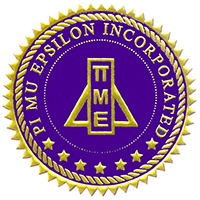Pi Mu Epsilon is the national mathematics honor society. The St. Bonaventure Department of Mathematics sponsors the New York Omega Chapter. Pi Mu Epsilon (abbreviated PME or ΠME) is dedicated both to promoting scholarly activity in mathematics and to recognizing mathematical achievement among students at academic institutions. Election into PME is based on mathematical achievement and overall scholarship.
Qualifications for Membership
 An undergraduate student at SBU may be elected to membership in the New York Omega Chapter of PME if the student satisfies all of the following requirements:
An undergraduate student at SBU may be elected to membership in the New York Omega Chapter of PME if the student satisfies all of the following requirements:
- completed MATH 151 (Calculus I) and MATH 152 (Calculus II) or their equivalents;
- completed at least six credits of mathematics courses at SBU from among the courses at the 200-level or higher that lead to the fulfillment of the requirements for a mathematics major;
- a GPA in his or her mathematics courses of 3.25 or higher;
- an overall GPA of 3.25 or higher;
- has a long-term commitment to mathematics, typically exhibited by declaring a minor or a major in mathematics or declaring a major in a closely-allied area.
For more information about our New York Omega Chapter, please contact the faculty organizer:
Dr. Christopher Hill
De La Roche 301 C
(716) 375-2025
Send an email.
Further information about Pi Mu Epsilon may be found at the PME website.
Spring 2025 Induction
On April 11, 2025, the Department of Mathematics inducted five students into the New York Omega Chapter of Pi Mu Epsilon. The inductees were Madigan Collver, ’26; Jackson Dry, ’26; Danielle Folland, ’26; Elizabeth Kraus, '25; and Nele Vetter, '26.
Dr. Maureen Cox inducted the new members, assisted by current PME member Alex Behr, '25. The ceremony was attended by friends, family, and faculty.
Each inductee received a handsome certificate and (according to their preference) either a PME pin or set of cords. Congratulations all!
Pi Mu Epsilon Journal
Pi Mu Epsilon publishes a biannual undergraduate mathematics journal called The PME Journal. Each issue includes a Problem Department that features interesting and accessible mathematics problems for undergraduates. The Department of Mathematics subscribes to The PME Journal and keeps recent issues in the Mathematics Suite.
Annual National Conference
The National Pi Mu Epsilon Council promotes scholarly activity in mathematics among students by sponsoring, in conjunction with the Mathematical Association of America, an annual national conference. The PME conference is held during the first week in August.
Undergraduate members of PME are encouraged to give 15-minute presentations on mathematical topics. The presentations need not include original research. Most students present explorations of topics that go beyond the content of traditional mathematics courses. In the past, Pi Mu Epsilon has provided travel funds for student speakers.
Students whose presentations are judged as outstanding are awarded cash prizes, which are provided by the American Mathematical Society.
History and Logo
 Pi Mu Epsilon was founded on May 25, 1914 at Syracuse University and currently has over 300 chapters at colleges and universities throughout the United States.
Pi Mu Epsilon was founded on May 25, 1914 at Syracuse University and currently has over 300 chapters at colleges and universities throughout the United States.
The New York Omega Chapter of PME was chartered at St. Bonaventure University on May 2, 1978.
The Pi Mu Epsilon logo, to the left, depicts the organization's shield, pin, and motto. The shield is divided into four parts. The upper right-hand section features the design of a conventionalized violet; the lower right-hand section shows a summation sign; the upper left-hand section shows an integral sign; and the lower left-hand sections shows three stars representing friendship, morality, and scholarship. Above the shield proper, the PME pin is represented. Below the shield, the PME motto, "To Promote Scholarship and Mathematics," appears in Greek. The logo is rendered in gold, violet, and lavender, which are the organization's colors.